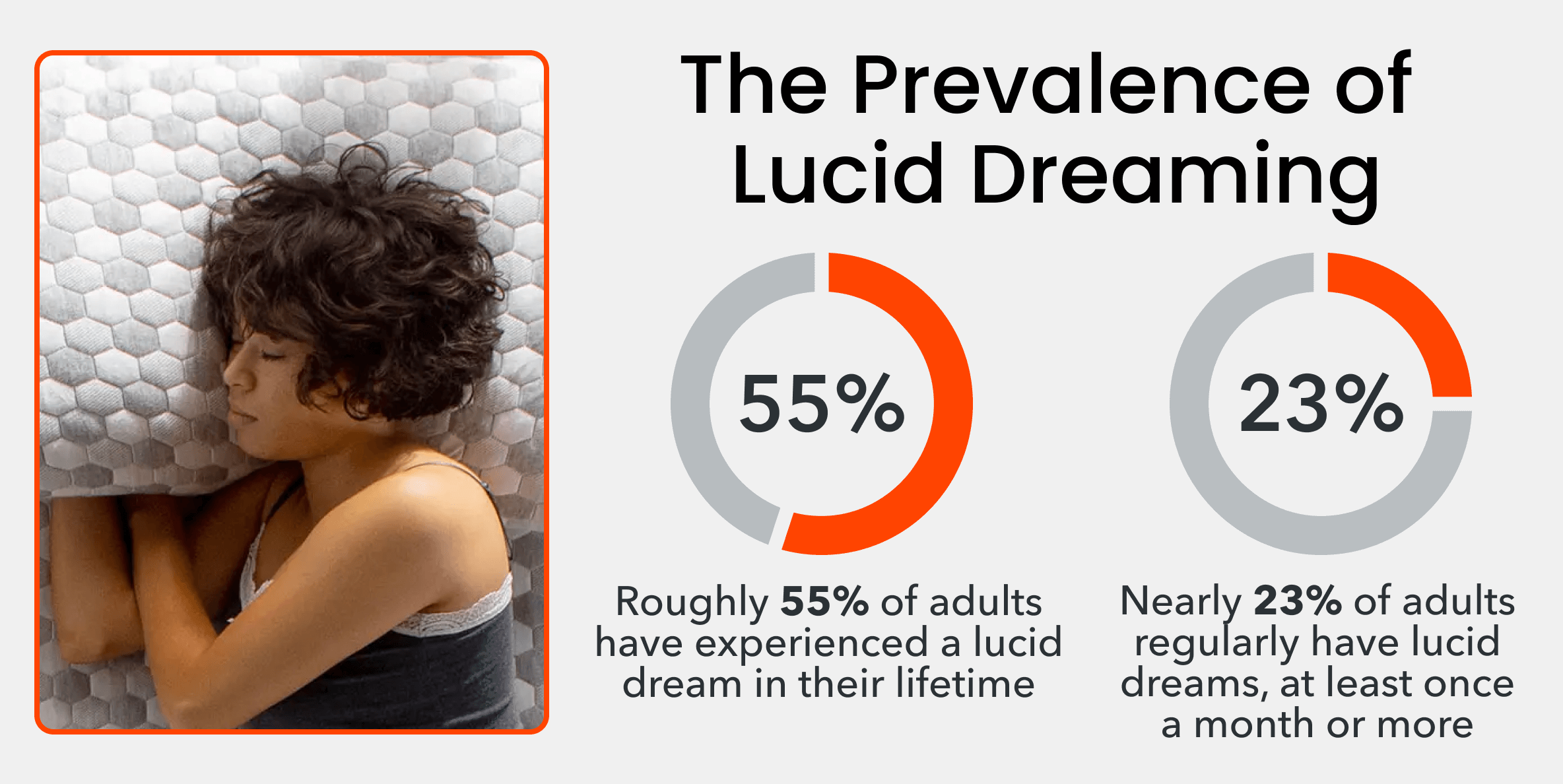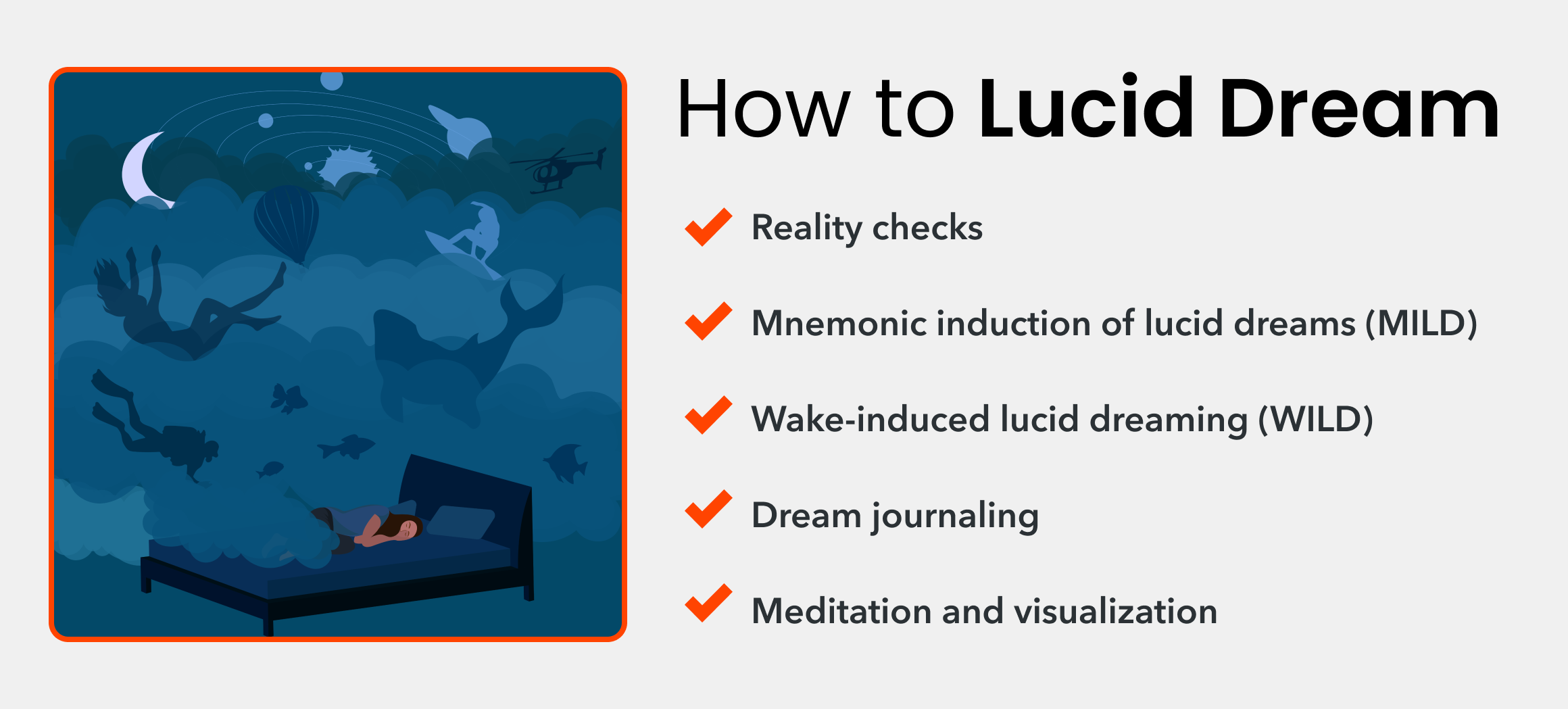What Is Lucid Dreaming?

Have you ever realized you were dreaming while still in the middle of a dream? That magical moment of awareness is what we call lucid dreaming. It’s like becoming the director of your own mental movie, where you can potentially influence the story as it unfolds.
While ordinary dreams sweep us along in their current, lucid dreams invite us to take the helm and steer our dream experience in fascinating new directions. So, what is lucid dreaming? Keep reading to find out.
- Key Takeaways
- What Is a Lucid Dream?
- What Causes Lucid Dreams?
- How Can You Tell if You’re Lucid Dreaming?
- When Do Lucid Dreams Occur?
- How Can You Have a Lucid Dream?
- What Are the Benefits of Lucid Dreaming?
- Can Lucid Dreaming Be Harmful?
- Lucid Dreaming: Taking Control of Your Dreams
Key Takeaways
- Lucid dreaming occurs when you become aware you’re dreaming while still in the dream state.
- Many adults have experienced at least one lucid dream, with 23% experiencing them monthly.
- Most lucid dreams happen during REM sleep, a crucial part of our natural sleep cycles.
- Various techniques like reality checks and dream journaling can help induce lucid dreams.
- While generally safe, maintaining good sleep habits is essential when exploring lucid dreaming.
What Is a Lucid Dream?
A lucid dream is more than just a vivid dream — it’s a unique state of consciousness where you’re aware that you’re dreaming while remaining asleep. Unlike regular dreams, where we’re passive observers of our subconscious mind’s creation, lucid dreams blur the line between sleeping and waking consciousness, creating a hybrid state that has fascinated scientists and dreamers alike.
The science behind lucid dreaming is particularly intriguing. Research shows that during lucid dreams, there’s increased activity in the frontal and temporal brain regions compared to regular deep sleep.1 These areas are associated with self-awareness and higher-order thinking, explaining why we can maintain conscious awareness during these special dreams.

What makes lucid dreams even more fascinating is their prevalence. Studies show that approximately 55% of adults have experienced at least one lucid dream in their lifetime, while 23% experience lucid dreams regularly, at least once a month.2 This suggests that lucid dreaming might be a natural capacity many of us possess but haven’t fully explored.
What Causes Lucid Dreams?
The exact mechanisms behind what causes dreams to become lucid aren’t fully understood, but research has identified several potential triggers.
Scientists have discovered that lucid dreams are caused by specific changes in brain connectivity, particularly involving the anterior prefrontal cortex (aPFC), which is the part of our brain responsible for higher-order thinking and metacognition (thinking about thinking).3
Interestingly, people who frequently experience lucid dreams show increased functional connectivity between the left aPFC and other important brain regions, including the angular gyrus and middle temporal gyrus. Think of it like these areas of the brain having a stronger communication network.
These regions work together to handle self-awareness and conceptual processing, essentially creating a mental environment where you can recognize that you’re in a dream state. This enhanced brain connectivity allows you to regain cognitive abilities typically suppressed during regular dreams, such as reflective consciousness and awareness of your state.
Some people are more likely to experience lucid dreams due to neurological conditions like narcolepsy.3 In contrast, others might encounter them during periods of disrupted sleep patterns or when waking up in the middle of the night.
Other studies suggest that lucid dreams often occur in a unique state between REM sleep and wakefulness.1
How Can You Tell if You’re Lucid Dreaming?
Recognizing a lucid dream isn’t always as straightforward as it might seem. Here are some reliable indicators that you’re experiencing a lucid dream:
- Conscious awareness of the dream state: You’ll experience a distinct moment of realization that you’re dreaming while still in the dream. This awareness often feels like a lightbulb moment where you suddenly understand that the reality you’re experiencing isn’t physical reality. You might think, “Wait a minute, this is a dream!”
- Ability to influence dream events: Once lucid, you’ll notice you can make conscious decisions within the dream. This might start with small actions like deciding to fly or walk through walls. The level of control can vary. Sometimes, you’ll have complete command over the dream environment, while other times, you might only be able to control your own actions.
- Heightened sensory experiences: Dreams become incredibly vivid and detailed during lucid states. Colors might appear more vibrant, textures feel more distinct, and you might even experience enhanced versions of taste, smell, and touch. These sensations often feel more intense than in regular dreams but may have a slightly different quality than waking life.
- Clear memory of the dream upon waking: Unlike regular dreams that often fade quickly, lucid dreams tend to remain vivid in your memory after waking. You’ll likely remember specific details, conversations, and events from the dream with unusual clarity. The experience often feels more like remembering a real event than a typical dream.
- Recognition of dream-specific inconsistencies: You’ll notice things that wouldn’t make sense in the waking world, but instead of accepting them as normal (like in regular dreams), you’ll be aware of their impossibility. This might include noticing that text changes when you look at it twice, realizing you can’t remember how you got to your current location, or observing that physical laws don’t work quite right.
When Do Lucid Dreams Occur?
To understand lucid dreams, you need to understand sleep cycles. Lucid dreams typically occur during REM sleep, the stage where most vivid dreams take place. This phase usually begins about 90 minutes after falling asleep and recurs throughout the night. As you progress through your sleep cycles, REM sleep gets longer. It’s often during these later REM stages where lucid dreams occur.
How Can You Have a Lucid Dream?
If you’re interested in experiencing lucid dreams, several techniques can potentially increase your chances of success.

- Reality checks: Perform regular reality checks throughout the day by questioning whether you’re dreaming. You can then transfer this habit into your dreams.
- Mnemonic induction of lucid dreams (MILD): Try to remember you’re dreaming before going to sleep, often while focusing on a recent dream.
- Wake-induced lucid dreaming (WILD): Maintain consciousness as you transition from wakefulness into REM sleep.
- Dream journaling: Keep a thorough dream journal to improve dream recall and recognize dream signs.
- Meditation and visualization: Practice mindfulness and visualization techniques to enhance awareness during both waking and dreaming states. Meditation for sleep can help calm your body and help you enter a lucid state.
The main goal is to make sure you’re getting enough quality sleep. Many people find that using a weighted blanket helps create a peaceful state of mind conducive to lucid dreaming practice, but what’s most important is ensuring a good night’s rest.
How Do You Get Out of a Lucid Dream?
Sometimes, you might want to exit a lucid dream. Here are effective methods to regain wakefulness:
- Blinking: Repeatedly blink your eyes in the dream state. This simple action helps bridge the gap between dreaming and waking consciousness, often triggering a natural transition to wakefulness.
- Focus on waking up: Concentrate intensely on the sensation of your physical body lying in bed. This redirection of awareness from the dream state to physical reality often helps break the dream state naturally.
- Shout or scream: Creating a loud vocal sound in your dream can stimulate your physical body enough to wake up. The intensity of the action often jolts you out of the dream state.
- Hold your breath: This technique triggers your body’s survival response when performed in the dream. Your natural instinct to breathe will often pull you into wakefulness.
- Use a sudden action: Make a dramatic movement like spinning or falling backward. These abrupt actions create enough sensory disruption to break the dream state.
- Read something: Since text is typically unstable in dreams, focusing on reading can help disrupt the dream state. The changing letters and words will often trigger awakening.
- Fall asleep: Let yourself drift off to sleep within your lucid dream. This paradoxical approach often naturally transitions you to either normal sleep or wakefulness.
What Are the Benefits of Lucid Dreaming?
Lucid dreaming offers several potential benefits that extend beyond the dream world into our waking lives:
- Enhanced creativity and problem-solving: The unique state of consciousness in lucid dreams can unlock creative insights and novel solutions to problems that you can transfer to other areas of your life, such as work or relationships.
- Improved emotional health: Processing difficult emotions and experiences in a controlled dream environment can aid emotional healing.
- Increased self-awareness: Regular lucid dreaming can lead to greater self-understanding and consciousness.
- Overcoming fears and nightmares: Lucid dreamers can face and overcome fears in a safe environment, which is particularly helpful for those experiencing nocturnal panic attacks or nightmares.
- Fun and exploration: Lucid dreams offer a playground for imagination and adventure without physical limitations.
Can Lucid Dreaming Be Harmful?
While lucid dreaming is generally considered safe, it’s important to approach it mindfully. Some potential risks include:
- Disrupted sleep quality if too much focus is placed on achieving lucidity: When you become overly focused on achieving lucid dreams, you might find yourself frequently checking your consciousness throughout the night. This constant mental effort can prevent you from falling into the deep, restorative sleep stages your body needs for proper rest and recovery.
- Sleep deprivation from excessive practice: Many lucid dreaming techniques involve waking up during the night or adjusting sleep schedules. If you practice these methods too frequently or intensively, you might get fewer hours of quality sleep. This can lead to daytime sleepiness and affect your overall well-being.
- Confusion between dream and waking states: Regular lucid dreaming can sometimes blur the lines between dreams and reality. Some people report experiencing “false awakenings,” where they think they’ve woken up but are still dreaming or briefly questioning reality during their waking hours. While usually temporary, this can be disorienting.
- Potential anxiety from intense dream experiences: Lucid dreams can sometimes feel overwhelmingly real and intense. This vivid experience might trigger anxiety or stress, especially if you encounter challenging scenarios or lose control of the dream. Some people also report feeling a sense of sleep paralysis or other unsettling sensations during their attempts at lucid dreaming.
Lucid Dreaming: Taking Control of Your Dreams
Lucid dreaming is a fascinating frontier in human consciousness, offering a unique blend of awareness and dreaming that can enrich our lives in surprising ways. Whether you’re seeking creative inspiration, emotional healing, or simply curious about exploring the depths of your mind, lucid dreaming provides a powerful tool for self-discovery and growth.
Ready to try lucid dreaming? Start by creating an optimal sleep environment with the right sleep products, such as a memory foam mattress or hybrid mattress designed to provide the comfort and support needed for quality rest and dream exploration.
References
- Voss U, Holzmann R, Tuin I, Hobson JA. Lucid dreaming: a state of consciousness with features of both waking and non-lucid dreaming. Sleep. 2009 Sep;32(9):1191-200.
- Adventure-Heart DJ. Findings From the International Lucid Dream Induction Study. Front Psychol. 2020 Jul 17;11:1746.
- Baird B, Castelnovo A, Gosseries O, Tononi G. Frequent lucid dreaming associated with increased functional connectivity between frontopolar cortex and temporoparietal association areas. Sci Rep. 2018 Dec 12;8(1):17798.







